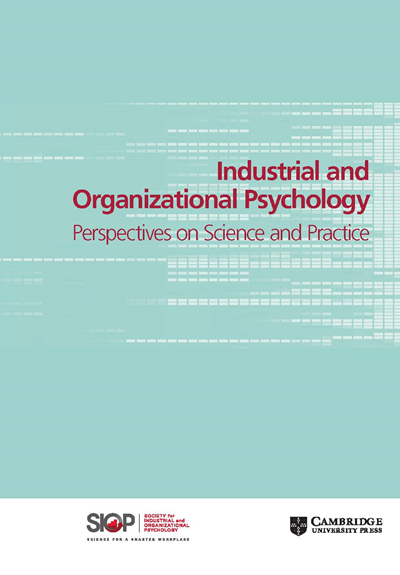Revisiting predictor–criterion construct congruence: Implications for designing personnel selection systems
IF 11.5
3区 心理学
Q1 PSYCHOLOGY, APPLIED
Industrial and Organizational Psychology-Perspectives on Science and Practice
Pub Date : 2023-08-31
DOI:10.1017/iop.2023.35
引用次数: 1
Abstract
Overview In their focal article, Sackett et al. (in press) describe implications of their new meta-analytic estimates of validity of widely used predictors for selection of employees. Contradicting the received wisdom of Schmidt and Hunter (1998), Sackett et al. conclude that predictor methods with content specifically tailored to jobs generally have greater validity for predicting job performance than general measures reflecting psychological constructs (e.g., cognitive abilities, personality traits). They also point out that standard deviations around the mean of their metaanalytic validity estimates are often large, leading to their question “why the variability?” (p. x). They suggest many legitimate contributors. We propose an additional moderator variable of critical importance: predictor-criterion construct congruence, accounting for a great deal of variability in validity coefficients found in meta-analysis. That is, the extent to which what is measured is congruent with what is predicted is an important determinant of the level of validity obtained. Sackett et al. (2022) acknowledge that the strongest predictors in their re-analysis are job-specific measures and that a “closer behavioral match between predictor and criterion” (p. 2062) might contribute to higher validities. Many in our field have also noted the importance of “behavioral consistency” between predictors and criteria relevant to selection, while also arguing for another type of congruence: the relationships between constructs in both the predictor and criterion space (e.g., Bartram, 2005; Campbell et al., 1993; Campbell & Knapp, 2001; Hogan & Holland, 2003; Hough, 1992; Hough & Oswald, 2005; Pulakos et al., 1988; Sackett & Lievens, 2008; Schmitt & Ostroff, 1986). The above reflects an important distinction between two types of congruence: behavior-based congruence and construct-based congruence. When ‘past behavior predicts future behavior’ (as might be possible for jobs requiring past experience and where behavior-oriented employment assessments such as interviews, biodata, and work samples are involved), behavior-based congruence exists. Behavior-based assessments can vary a great deal across jobs but tend to ask about past experiences that are influenced by a complex mix of KSAOs. By contrast, constructbased congruence aligns employment tests of job-relevant KSAOs (e.g., verbal and math skills, conscientiousness) with relevant work criteria, such as technical performance or counterproductive work behavior (e.g., Campbell & Wiernik, 2015). What we are suggesting strongly here is that regardless of the approach to congruence adopted in selection, it is the congruence between predictor and criterion constructs that is a key factor重新审视预测-标准-结构一致性:对人事选择系统设计的启示
概述在他们的重点文章中,Sackett等人(出版中)描述了他们对广泛使用的员工选择预测因子有效性的新元分析估计的含义。与Schmidt和Hunter(1998)的公认观点相矛盾,Sackett等人得出结论,与反映心理结构(如认知能力、性格特征)的一般测量相比,内容专门针对工作的预测方法在预测工作表现方面通常具有更大的有效性。他们还指出,元分析有效性估计的平均值周围的标准差通常很大,这导致了他们的问题“为什么会有可变性?”(第x页)。他们提出了许多合法的贡献者。我们提出了一个额外的具有关键重要性的调节变量:预测标准-结构一致性,解释了荟萃分析中有效性系数的大量可变性。也就是说,测量的内容与预测的内容一致的程度是所获得的有效性水平的重要决定因素。Sackett等人(2022)承认,在他们的重新分析中,最强的预测因素是特定于工作的衡量标准,“预测因素和标准之间更紧密的行为匹配”(第2062页)可能有助于提高有效性。我们领域的许多人也注意到了与选择相关的预测因素和标准之间“行为一致性”的重要性,同时也主张另一种类型的一致性:预测空间和标准空间中的结构之间的关系(例如,Bartram,2005;Campbell等人,1993;Campbell&Knapp,2001;Hogan和Holland,2003;Hough,1992;Hough和Oswald,2005;Pulakos等人,1988;Sackett和Lievens,2008;Schmitt和Ostroff,1986)。以上反映了两种类型的一致性之间的重要区别:基于行为的一致性和基于结构的一致性。当“过去的行为预测未来的行为”时(对于需要过去经验的工作以及涉及面试、生物数据和工作样本等以行为为导向的就业评估的工作来说,这可能是可能的),基于行为的一致性是存在的。基于行为的评估可能因工作而异,但往往会询问过去的经历,这些经历受到复杂的KSAO组合的影响。相比之下,基于结构的一致性将与工作相关的KSAO的就业测试(例如,语言和数学技能、尽责性)与相关的工作标准相一致,例如技术表现或适得其反的工作行为(例如,Campbell&Wiernik,2015)。我们在这里强烈建议的是,无论在选择中采用何种方法来实现一致性,预测结构和标准结构之间的一致性都是一个关键因素
本文章由计算机程序翻译,如有差异,请以英文原文为准。
求助全文
约1分钟内获得全文
求助全文
来源期刊

Industrial and Organizational Psychology-Perspectives on Science and Practice
PSYCHOLOGY, APPLIED-
CiteScore
7.70
自引率
10.10%
发文量
85
期刊介绍:
Industrial and Organizational Psychology-Perspectives on Science and Practice is a peer-reviewed academic journal published on behalf of the Society for Industrial and Organizational Psychology. The journal focuses on interactive exchanges on topics of importance to the science and practice of the field. It features articles that present new ideas or different takes on existing ideas, stimulating dialogue about important issues in the field. Additionally, the journal is indexed and abstracted in Clarivate Analytics SSCI, Clarivate Analytics Web of Science, European Reference Index for the Humanities and Social Sciences (ERIH PLUS), ProQuest, PsycINFO, and Scopus.
 求助内容:
求助内容: 应助结果提醒方式:
应助结果提醒方式:


